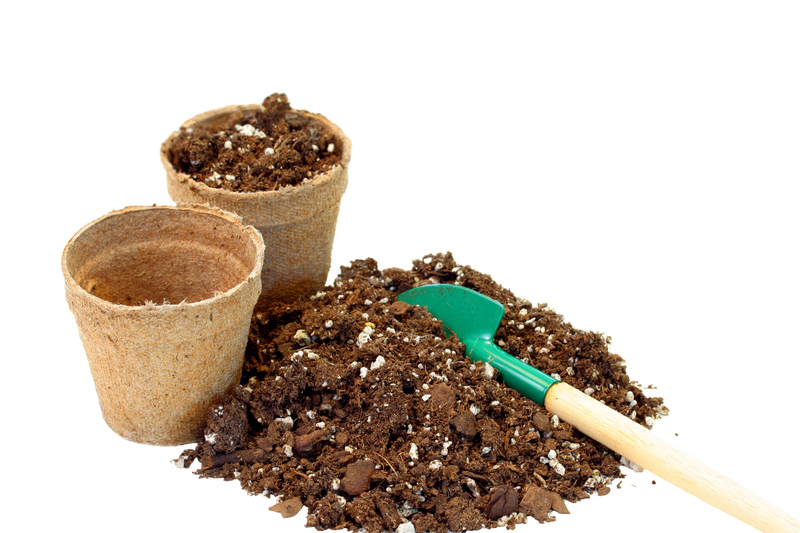Nurture Nature: How Your Garden Contributes to Climate Solutions
Posted on 28/06/2025
Nurture Nature: How Your Garden Contributes to Climate Solutions
Gardening is more than a simple hobby - it is a powerful tool against climate change, right in your own backyard. Many people underestimate how their gardens can make a real difference in environmental health and global warming mitigation. In this comprehensive guide, we will explore how your garden supports climate solutions, reveal science-backed gardening practices to boost your climate impact, and inspire you to nurture nature for a healthier planet.
The Science: Why Gardens Matter for the Planet
The climate crisis affects us all, and while policy changes and technological innovation are crucial, individual efforts like sustainable gardening play a surprisingly significant role. When you cultivate plants, manage soil, and encourage biodiversity, you're essentially joining a global network of eco-minded citizens contributing to tangible climate solutions.
- Gardens act as carbon sinks, trapping CO2 in plant tissue and soil.
- They support urban cooling, reducing heat island effects.
- Sustainable gardens promote water conservation and healthier ecosystems.
- Gardens can even help lower your household's carbon footprint by growing your own food.

Understanding the Carbon Cycle in Your Backyard
Plants lie at the heart of the climate system. Through photosynthesis, they absorb atmospheric carbon dioxide and convert it into oxygen and organic matter, storing carbon in roots, trunks, and leaves. A well-managed garden enhances this natural process, acting as a small-scale carbon sequestration hub. Soil health is equally vital: healthy, living soils trap more carbon, reducing greenhouse gases in the atmosphere.
Soil: The Powerful Carbon Sponge Beneath Our Feet
Soil is more than dirt--it's a complex, living ecosystem. Healthy soils store nearly three times more carbon than the atmosphere. By nurturing your soil with compost, mulches, and natural amendments, you're helping to lock away carbon and support beneficial microbes that enhance plant growth.
- Composting: Transforming kitchen and garden waste into nutrient-rich compost reduces methane from landfills and improves soil carbon content.
- Mulching: A layer of organic mulch keeps soils cool, moist, and protected from erosion, further supporting carbon storage.
- Cover Crops: Plants like clover or vetch prevent soil erosion and boost soil fertility and carbon retention.
Climate-Resilient Gardening: Key Techniques and Tips
Building a climate-smart garden involves adopting practices that not only help mitigate climate change but also make your green space more resilient to extreme weather. Here are actionable ways to harness your garden for climate solutions:
1. Plant More Trees and Shrubs
Trees and shrubs are your garden's champions in the fight against climate change. Large, woody plants sequester more carbon over their lifetime than annuals and provide cooling shade, vital for combating urban heat islands.
- Choose native and drought-tolerant species to increase biodiversity and minimize watering needs.
- Strategically placed trees can lower home energy usage by providing summer shade and winter wind protection.
- Fruit-bearing trees support wildlife and can supplement your table, slashing the carbon footprint of imported produce.
2. Grow Your Own Produce
Food production is a major contributor to climate change, particularly when it comes to transporting produce long distances (food miles) and intensive industrial agriculture. By growing vegetables, herbs, and fruit at home, you're:
- Reducing food miles and packaging waste.
- Minimizing chemical inputs by choosing organic or natural fertilizers.
- Building climate resilience by selecting crops suited to your region's growing conditions.
- Encouraging biodiversity in your garden ecosystem.
3. Water Wisely
Climate change often means more unpredictable rainfall patterns. Smart water management in your garden conserves this vital resource and reduces dependency on municipal water, which often relies on energy-intensive pumping and treatment.
- Install rain barrels to capture and store rainwater for irrigation.
- Mulch to retain soil moisture, reducing watering needs.
- Use drip irrigation or soaker hoses for efficient watering and minimal evaporation.
- Choose drought-resistant plants to withstand dry spells.
4. Foster Biodiversity and Local Wildlife
A diverse garden supports climate adaptation and resilience. Indigenous plants attract local pollinators, birds, and beneficial insects--essential for maintaining ecosystem health and stability.
- Plant a mix of flowering species to provide nectar throughout the season.
- Leave some garden corners "wild" as wildlife habitat.
- Avoid chemical pesticides to protect pollinator populations.
- Include water sources and nesting sites for birds and insects.
Reducing Emissions: Smart Gardening Choices
You don't need a huge property to make climate-smart decisions. Every small step, from the tools you use to your gardening methods, adds up over time. Here's how to further cut your garden's climate footprint:
Select Manual or Electric Tools
- Swap out gas-powered lawnmowers, blowers, and trimmers for manual or battery-electric alternatives. Gas lawn equipment generates as much pollution in an hour as driving a car tens of miles! This simple swap can dramatically cut your garden's direct greenhouse emissions.
Avoid Synthetic Fertilizers and Pesticides
- Manufacture and overuse of chemical fertilizers: Contributes to nitrous oxide emissions--a greenhouse gas almost 300 times more potent than CO2! Use natural compost, leaf mold, and organic amendments instead.
- Practice integrated pest management (IPM): Use beneficial insects, manual removal, or natural deterrents to control pests.
Try No-Dig and Minimal Disturbance Techniques
- No-dig gardening keeps carbon stored in the soil and protects soil structure. Just add compost or mulch to the surface and allow worms to do the work.
- Sheet mulching and lasagna gardening are methods that build fertility without tillage.
Urban Gardens: Cooling Cities and Combating Air Pollution
City landscapes are notorious for the "heat island effect," where concrete and asphalt absorb and radiate heat, making urban areas noticeably warmer than rural surroundings. Plants help cool cities naturally:
- Trees, shrubs, and green roofs reduce ambient temperatures through shade and evapotranspiration.
- Gardens trap airborne pollutants, improve urban air quality, and provide mental health benefits for city dwellers.
- Community and rooftop gardens transform underutilized spaces into carbon-sequestering oases.
Improving Air Quality and Well-being
Vegetation absorbs pollutants such as nitrogen oxides, ozone, and particulate matter, making the air around gardens cleaner and safer to breathe. Even small gardens can make a measurable difference in urban environments, supporting both environmental health and community well-being.
Community Gardens and Collective Action
Individual gardens are powerful, but when communities garden together, the impact multiplies. Community gardens in schools, parks, and neighborhoods can:
- Increase urban green space and air quality.
- Strengthen food security and provide fresh, local produce.
- Support habitat for pollinators and native species.
- Foster environmental education and stewardship.
If you don't have space for a private garden, joining a community project is a wonderful way to participate in collective climate solutions. Many cities offer allotment programs or support for rooftop and balcony gardens.
The Circular Garden: Waste Reduction and Closed-Loop Solutions
A truly sustainable garden is a circular system--one that recycles nutrients, conserves resources, and minimizes waste. You can nurture nature by:
- Composting all organic waste from your kitchen and garden.
- Switching to peat-free compost and avoiding single-use plastic pots.
- Saving seeds from your healthiest plants for next season.
- Creating wildlife-friendly zones with logs, leaves, and stones to support decomposers.
Educational Impact: Inspiring the Next Generation
Gardening isn't just about plants--it's about people, knowledge, and future generations. Teaching children to garden ingrains a respect for nature, understanding of the carbon cycle, and first-hand experience with solutions to climate change. Schools and families can work together to:
- Integrate climate-friendly gardening into education curriculums.
- Foster a sense of climate responsibility and empowerment.
- Develop hands-on STEM skills through observing composting, plant growth, and ecosystem interactions.

Measuring your Climate Impact: Tools and Techniques
Curious about the difference your sustainable gardening efforts are making? There are practical ways to measure your garden's climate contributions:
- Track the volume of compost you produce and apply. Scientists estimate that every pound of composted waste avoids at least half a pound of carbon dioxide emissions compared with landfill disposal.
- Use citizen science apps to monitor local biodiversity and submit data on pollinators, birds, and plant health.
- Estimate how much produce you're growing versus buying, and the reduction in associated "food miles."
- Join online communities dedicated to climate-positive gardening and share your progress, learning from the experiences of others.
Your Garden, Your Contribution to Climate Solutions
It's easy to feel overwhelmed by the scale of the climate crisis, but remember that every positive action adds up. When you nurture your garden, you nurture the planet--one tree, one patch of soil, one pollinator at a time. Your backyard can become a sanctuary for carbon sequestration, biodiversity, and environmental health.
To sum up, your garden is more than a private retreat--it's a direct investment in the planet's future. With mindful practices, shared knowledge, and a love for nature, we can all make a real climate difference from the ground up. Start today and let your own patch of earth be part of the solution!
Key Takeaways:
- Your garden can sequester carbon and fight climate change.
- Adopt sustainable, low-emission gardening practices for maximum benefit.
- Enhance biodiversity, conserve water, and grow your own food.
- Join community gardening efforts for greater collective impact.
- Educate and inspire others to nurture nature for climate resilience.
Together, by nurturing our gardens, we nurture nature--and build a more sustainable world for all.

